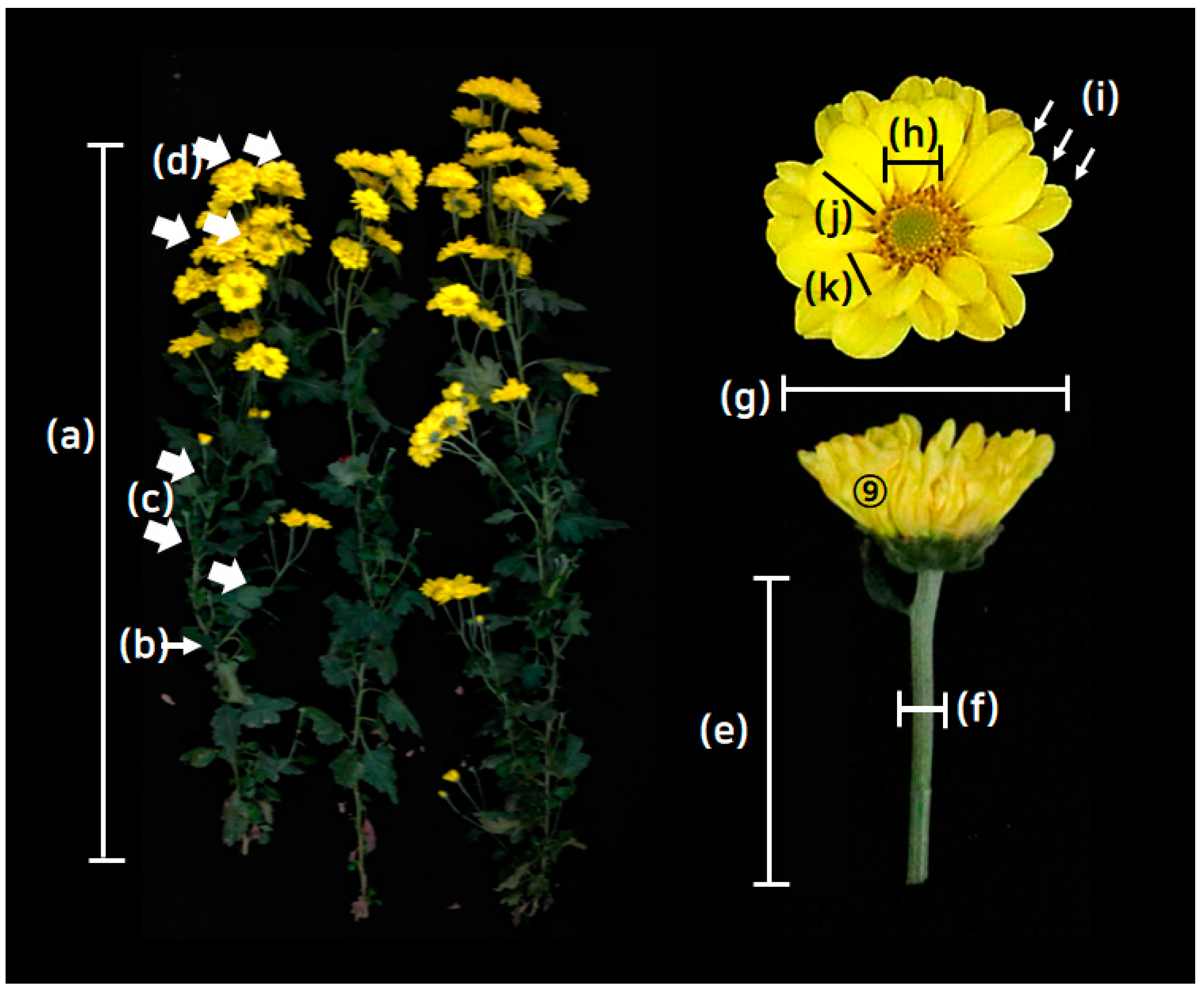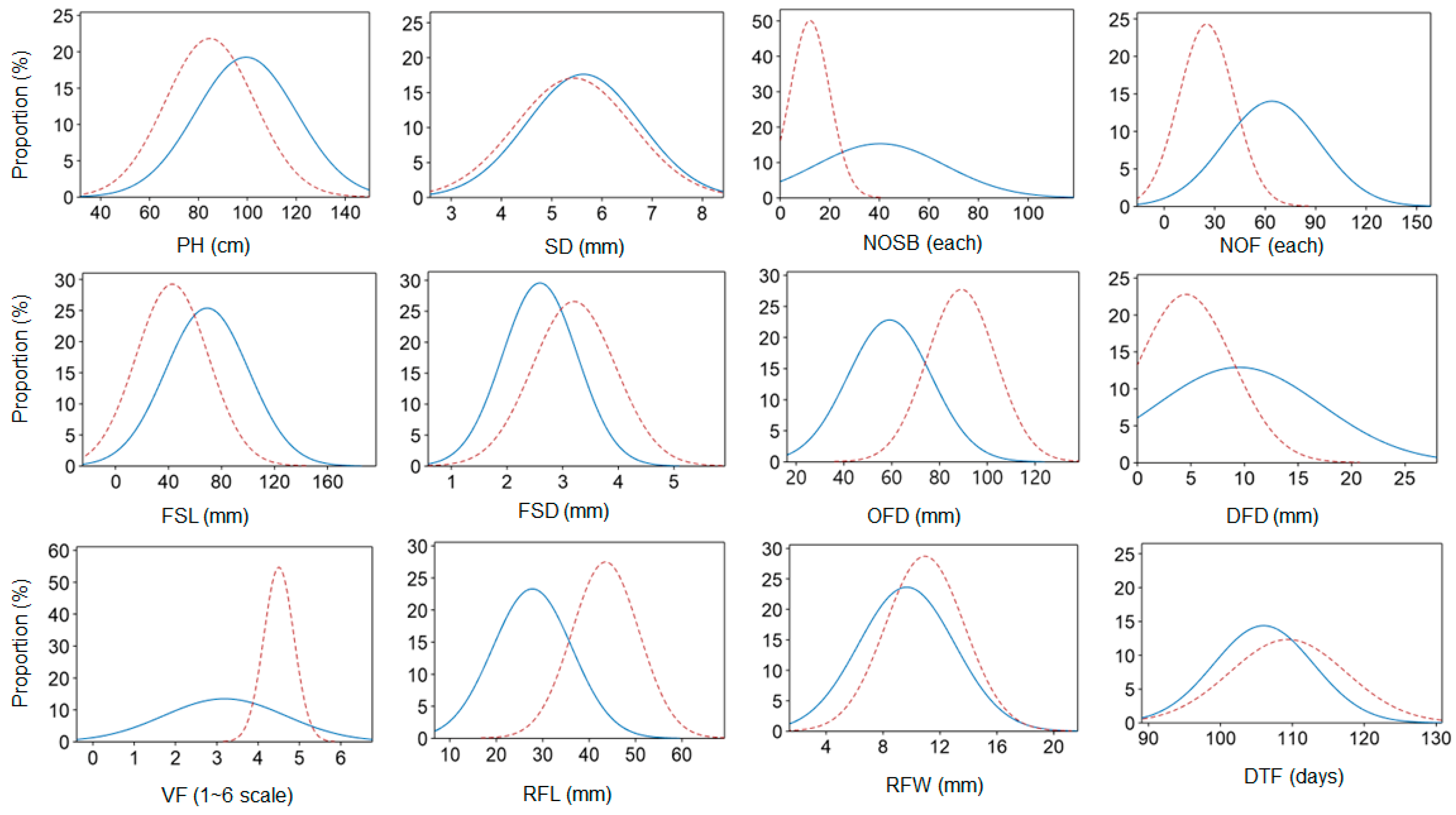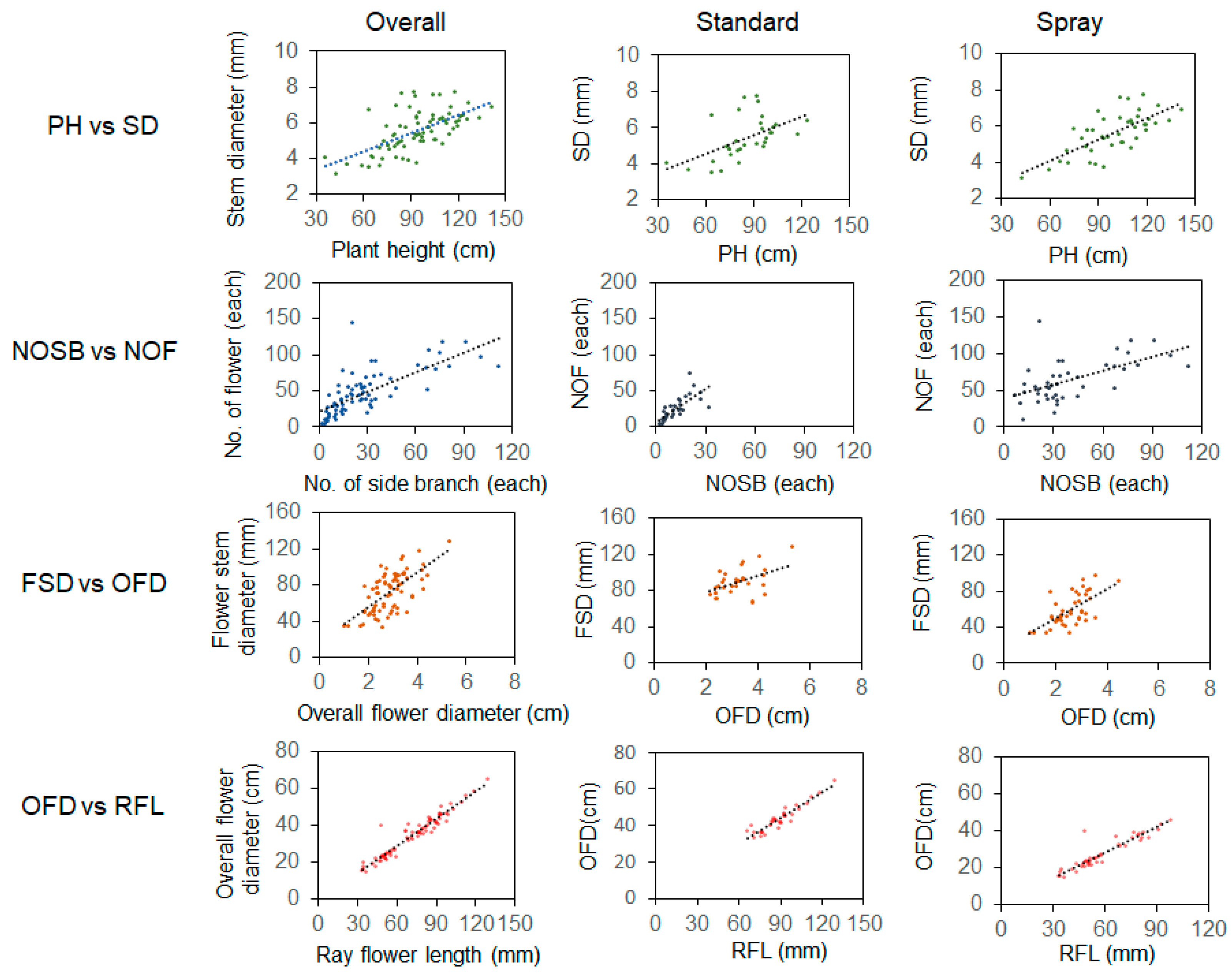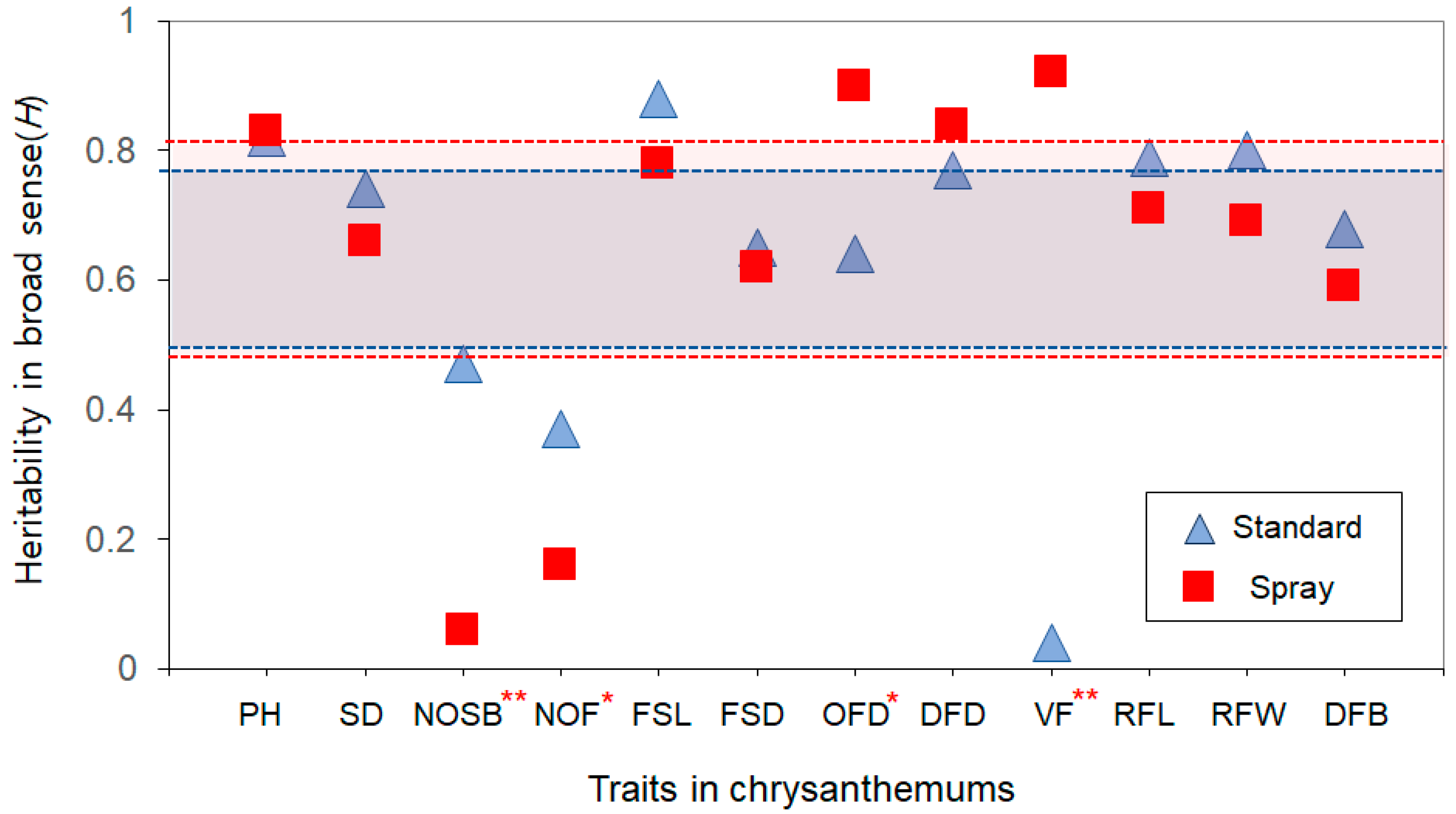Assessing Amounts of Genetic Variability in Key Horticultural Traits Underlying Core Korean Breeding Lines of Cut Chrysanthemums
Abstract
1. Introduction
2. Results
2.1. Phenotypic Variation
2.2. Trait Correlations
2.3. Genetic and Phenotypic Coefficients (GCV and PCV)
2.4. Heritability
3. Discussion
3.1. The Correlation and the Multivariate Analyses to Explore Trait Association between the Standard and Spray Chrysanthemum Lines
3.2. GCV and PCV among the Standard and Spray Chrysanthemum Lines
4. Materials and Methods
4.1. Plant Materials and Preparation
4.2. Phenotypic Evaluation and Data Analysis
4.3. Estimation of the Heritability
5. Conclusions
Supplementary Materials
Author Contributions
Funding
Data Availability Statement
Conflicts of Interest
References
- Mekapogu, M.; Kwon, O.; Song, H.; Jung, J. Towards the Improvement of Ornamental Attributes in Chrysanthemum: Recent Progress in Biotechnological Advances. Int. J. Mol. Sci. 2022, 23, 12284. [Google Scholar] [CrossRef]
- Van Huylenbroeck, J. Chrysanthemum. In Ornamental Crops; Springer International Publishing AG: Cham, Switzerland, 2018; Volume 11, pp. 319–348. [Google Scholar]
- Kumari, S.; Dhiman, S.R.; Gupta, Y.C. Advances in Breeding of Chrysanthemum: A Review. Int. J. Curr. Microbiol. Appl. Sci. 2019, 8, 1631–1643. [Google Scholar] [CrossRef]
- Su, J.; Jiang, J.; Zhang, F.; Liu, Y.; Ding, L.; Chen, S.; Chen, F. Current achievements and future prospects in the genetic breeding of chrysanthemum: A review. Hortic. Res. 2019, 6, 109. [Google Scholar] [CrossRef]
- Song, S.H.; Kim, S. Analysis of Export Competitiveness and Intra Industry Trade of Korean Flower: Focusing on Roses, Chrysanthemums, and Lilies. Korean J. Agric. Manag. Policy 2021, 48, 106–132. [Google Scholar] [CrossRef]
- Sasaki, K.; Tanaka, T. Overcoming Difficulties in Molecular Biological Analysis through a Combination of Genetic Engineering, Genome Editing, and Genome Analysis in Hexaploid Chrysanthemum morifolium. Plants 2023, 12, 2566. [Google Scholar] [CrossRef]
- Nakano, M.; Hirakawa, H.; Fukai, E.; Toyoda, A.; Kajitani, R.; Minakuchi, Y.; Itoh, T.; Higuchi, Y.; Kozuka, T.; Bono, H.; et al. A chromosome-level genome sequence of Chrysanthemum seticuspe, a model species for hexaploid cultivated chrysanthemum. Commun. Biol. 2021, 4, 1167. [Google Scholar] [CrossRef] [PubMed]
- Song, A.; Su, J.; Wang, H.; Zhang, Z.; Zhang, X.; Van De Peer, Y.; Chen, F.; Fang, W.; Guan, Z.; Zhang, F.; et al. Analyses of a chromosome-scale genome assembly reveal the origin and evolution of cultivated chrysanthemum. Nat. Commun. 2023, 14, 2021. [Google Scholar] [CrossRef] [PubMed]
- Dey, P. Estimation of Phenotypic Coefficients of Variation (PCV), Genotypic Coefficients of Variation (GCV), Heritability and Genetic Gain for Yield and its Components in Rice Landraces of Odisha. Int. J. Agric. Environ. &Amp; Biotechnol. 2019, 12, 181–185. [Google Scholar] [CrossRef]
- Kadium, V.R.; Svyantek, A.; Svyantek, A. Broad-Sense Heritability for Horticultural Production Traits in Eggplant. Crop Breed. Genet. Genom. 2023, 5(2), e230003. [Google Scholar] [CrossRef]
- Singh, D.; Tyagi, S.; Singh, S.; Ray, P. Studies on the Performance and Flower Characterization of Chrysanthemum (Dendranthema grandiflora L.) Genotypes under Uttar Pradesh Conditions. Adv. Res. 2017, 9, 1–7. [Google Scholar] [CrossRef]
- Patil, S.; Nagar, K.K.; Sumana, D.A. Variability, Heritability and Genetic Advance in Chrysanthemum (Chrysanthemum morifolium Ramat.) under Ecological Conditions of Sub-Humid Zone of Rajasthan. Int. J. Curr. Microbiol. Appl. Sci. 2019, 8, 1774–1782. [Google Scholar] [CrossRef]
- Verma, A.K.; Sahukla, S. Studies on genetic variability, heritability and genetic advance in large flower chrysanthemum. J. Ornam. Hortic. 2018, 21, 31. [Google Scholar] [CrossRef]
- Tesfaye, A. Genetic Variability, Heritability, and Genetic Advance Estimates in Garlic (Allium sativum) from the Gamo Highlands of Southern Ethiopia. Int. J. Agron. 2021, 2021, 1–8. [Google Scholar] [CrossRef]
- Rasheed, A.; Ilyas, M.; Khan, T.N.; Mahmood, A.; Riaz, U.; Chattha, M.B.; Al Kashgry, N.A.T.; Binothman, N.; Hassan, M.U.; Wu, Z.; et al. Study of genetic variability, heritability, and genetic advance for yield-related traits in tomato (Solanum lycopersicon MILL.). Front. Genet. 2023, 13, 1030309. [Google Scholar] [CrossRef] [PubMed]
- Baskaran, V.; Jayanthi, R.; Janakiram, T.K. Abirami Studies on Genetic Variability, Heritability and Genetic Advance in Chrysanthemum. J. Hortic. Sci. 2009, 4, 174–176. [Google Scholar] [CrossRef]
- Bennurmath, P.; Kumar, R.; Nair, S.A.; Dhananjaya, M.V.; Laxman, R.H. Studies on Genetic Variability, Heritability, Correlation and Path Analysis in Chrysanthemum (Dendranthema grandiflora Tzvelev). Int. J. Bio-Resour. Stress Manag. 2022, 13, 213–218. [Google Scholar] [CrossRef]
- Tavakol, M.; Wetzel, A. Factor Analysis: A means for theory and instrument development in support of construct validity. Int. J. Med. Educ. 2020, 11, 245–247. [Google Scholar] [CrossRef]
- Shim, S.; Kim, K.; Kim, C.; Chung, M.; Kim, K.; Chung, J. Morphological characteristics and coefficient of variation, heritability and genetic advance of major cultivars of spray chrysanthemum. Korean J. Hortic. Sci. Technol. 2016, 34, 269–281. [Google Scholar] [CrossRef][Green Version]
- Shim, S.; Lim, K.; Kim, C.; Chung, M.; Kim, K.; Chung, J. Variation Coefficient, Heritability and Genetic Advance Rate Related with Morpho-Physiological Characteristics of Individual Organ Part of Spray Chrysanthemum. Flower Res. J. 2016, 24, 29–41. [Google Scholar] [CrossRef]
- Gautam, A.; Suresh, J.; Madhav, M.S. Study of Genetic Variability in Genotypes of Rice (Oryza sativa L.). Res. J. Agric. Sci. 2016, 7, 235–236. [Google Scholar]
- Zhang, X.; Su, J.; Jia, F.; He, Y.; Liao, Y.; Wang, Z.; Jiang, J.; Guan, Z.; Fang, W.; Chen, F.; et al. Genetic architecture and genomic prediction of plant height-related traits in chrysanthemum. Hortic. Res. 2023, 11, uhad236. [Google Scholar] [CrossRef] [PubMed]
- Tiwari, D.N.; Tripathi, S.R.; Tripathi, M.P.; Khatri, N.; Bastola, B.R. Genetic Variability and Correlation Coefficients of Major Traits in Early Maturing Rice under Rainfed Lowland Environments of Nepal. Adv. Agric. 2019, 5975901. [Google Scholar] [CrossRef]
- Covarrubias-Pazaran, G. Genome-assisted prediction of quantitative traits using the R package sommer. PLoS ONE 2016, 11, e0156744. [Google Scholar] [CrossRef] [PubMed]





| Traits | GCV z (%) | PCV y (%) | H x | |||
|---|---|---|---|---|---|---|
| Standard | Spray | Standard | Spray | Standard | Spray | |
| PH | 19.70 | 19.44 | 22.88 | 21.26 | 0.82 | 0.83 |
| SD | 19.63 | 16.89 | 22.71 | 20.73 | 0.74 | 0.66 |
| NOSB | 47.78 | 15.73 | 68.06 | 63.22 | 0.47 | 0.06 |
| NOF | 42.79 | 19.65 | 69.95 | 48.27 | 0.37 | 0.16 |
| FSL | 62.01 | 40.82 | 65.74 | 46.17 | 0.88 | 0.78 |
| FSD | 19.01 | 21.09 | 24.26 | 26.59 | 0.65 | 0.62 |
| OFD | 13.55 | 27.78 | 16.97 | 29.22 | 0.64 | 0.9 |
| DFD | 83.86 | 71.11 | 95.51 | 77.57 | 0.77 | 0.84 |
| VF | 1.94 | 44.31 | 8.69 | 45.99 | 0.04 | 0.92 |
| RFL | 15.26 | 25.54 | 17.19 | 30.2 | 0.79 | 0.71 |
| RFW | 23.05 | 28.87 | 25.69 | 34.53 | 0.80 | 0.69 |
| DTF | 12.80 | 9.98 | 15.56 | 13.04 | 0.68 | 0.59 |
| Mean | 30.12 | 28.43 | 37.77 | 38.07 | 0.64 | 0.65 |
| Upper 95% w | 45.39 | 39.07 | 55.98 | 50.06 | 0.79 | 0.82 |
| Lower 95% u | 14.84 | 17.80 | 19.55 | 26.07 | 0.49 | 0.47 |
Disclaimer/Publisher’s Note: The statements, opinions and data contained in all publications are solely those of the individual author(s) and contributor(s) and not of MDPI and/or the editor(s). MDPI and/or the editor(s) disclaim responsibility for any injury to people or property resulting from any ideas, methods, instructions or products referred to in the content. |
© 2024 by the authors. Licensee MDPI, Basel, Switzerland. This article is an open access article distributed under the terms and conditions of the Creative Commons Attribution (CC BY) license (https://creativecommons.org/licenses/by/4.0/).
Share and Cite
Kim, S.-Y.; Lee, H.-Y.; Park, C.; Kim, D.; Kim, J.-B.; Kim, S.-H.; Jeong, K.-J.; Pak, H.-S.; Jung, J.-A.; Kim, T.-S. Assessing Amounts of Genetic Variability in Key Horticultural Traits Underlying Core Korean Breeding Lines of Cut Chrysanthemums. Plants 2024, 13, 577. https://doi.org/10.3390/plants13050577
Kim S-Y, Lee H-Y, Park C, Kim D, Kim J-B, Kim S-H, Jeong K-J, Pak H-S, Jung J-A, Kim T-S. Assessing Amounts of Genetic Variability in Key Horticultural Traits Underlying Core Korean Breeding Lines of Cut Chrysanthemums. Plants. 2024; 13(5):577. https://doi.org/10.3390/plants13050577
Chicago/Turabian StyleKim, Seung-Young, Haying-Youl Lee, Chanrim Park, Daegwan Kim, Jung-Bun Kim, So-Hyun Kim, Kyeong-Jin Jeong, Ha-Seung Pak, Jae-A Jung, and Tae-Sung Kim. 2024. "Assessing Amounts of Genetic Variability in Key Horticultural Traits Underlying Core Korean Breeding Lines of Cut Chrysanthemums" Plants 13, no. 5: 577. https://doi.org/10.3390/plants13050577
APA StyleKim, S.-Y., Lee, H.-Y., Park, C., Kim, D., Kim, J.-B., Kim, S.-H., Jeong, K.-J., Pak, H.-S., Jung, J.-A., & Kim, T.-S. (2024). Assessing Amounts of Genetic Variability in Key Horticultural Traits Underlying Core Korean Breeding Lines of Cut Chrysanthemums. Plants, 13(5), 577. https://doi.org/10.3390/plants13050577






